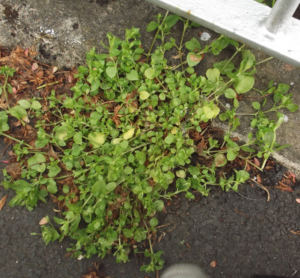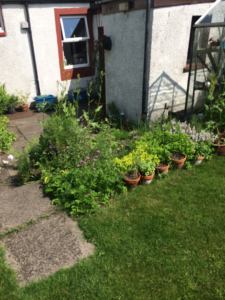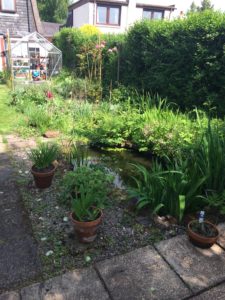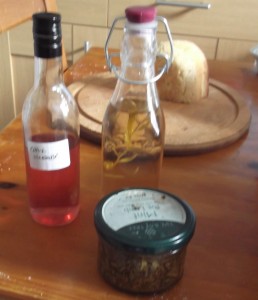
Well not so much territory of rain this week. It is beautifully hot and sunny, and after everything in the garden hanging fire for about a fortnight, it has all started happening at once. Seeds have grown (but so have a million weeds), the thyme and sage have come into flower, and I have started harvesting. Chives are in the freezer and I have made tarragon and basil vinegar.
I’ve found some chickweed

not this plant, I hasten to add – it is very near to territory marking posts of dogs and foxes – and I am infusing it into oil. I’ve done the same for cleavers (I wish I could say they weren’t from my garden, but they are), and I’ve made some hawthorn flower tincture

I will be drying the thyme and sage,
 plus some lovely sprays of eucalyptus and bay my friend Rita Bradd brought me, when she came to discuss editing her new pamphlet of poems, which will be out in September. She also brought me a hand of ginger, and as I noticed a little growth spur on it, I’ll be planting up a division of it to see if I can grow it on. There are cuttings to take too, so I am looking forward to a very busy weekend.
plus some lovely sprays of eucalyptus and bay my friend Rita Bradd brought me, when she came to discuss editing her new pamphlet of poems, which will be out in September. She also brought me a hand of ginger, and as I noticed a little growth spur on it, I’ll be planting up a division of it to see if I can grow it on. There are cuttings to take too, so I am looking forward to a very busy weekend.
Elsewhere, the black backed gulls have pretty much moved on from their old nesting site. I only counted three yesterday, nesting on chimney pots. But on the plus side, there are more housemartins and swallows and swifts than ever, and I hope they will rear broods successfully. The robins abandoned their nest in the ivy pot, but they must have found somewhere else because there are baby robins and blue tits in the garden. The magpies that were a problem in other years seem to have taken themselves off, so the small birds are very active. There are frogs and newts in the pond, and I’m hoping this year will repair some of the damage last year’s cold and wet did to our wildlife.



